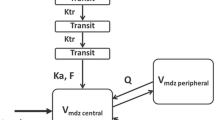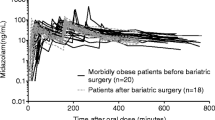Abstract
Following an overnight fast and 2 days of abstention from caffeine, a single 1.0-g oral dose of antipyrine was administered to 20 obese but otherwise healthy subjects (group A) and 11 healthy volunteers (group B). Weight, Body Mass Index (BMI) and % of Ideal Body Weight (IBW) were significantly greater in the obese than in the lean group. (Mean 110.4 vs 62.7 kg; 38.5 vs 22.3 kg · m−2 and 181vs 106 % respectively). In a subgroup of 6 obese subjects (group C) antipyrine was given again 11.3 months later after a 29.8 kg mean weight loss.
Antipyrine apparent volume of distribution (V) and elimination half-life (t 1/2) were significantly greater in the obese than in the lean group (V 49.9 vs 34.3 l respectively; t 1/2 15.5 vs 12.0 h respectively), but its clearance rate (CLo) values were similar. V corrected for total body weight was significantly reduced in group A than in group B (0.45 vs 0.55 l · kg−1 respectively). Stratified comparison of antipyrine pharmacokinetics between obese and lean subjects according to age, gender and smoking habits did not alter the overall results. In group C, weight reduction was associated with a significant decrease in antipyrine V (from 51.8 to 47.5 l) and t 1/2 (from 15.1 to 12.7 h), and a non-significant increase in antipyrine CLo.
We conclude that in severely obese subjects, antipyrine total V is mildly increased but V corrected for total body weight is significantly decreased. In addition, obesity is associated with a slight prolongation of antipyrine t 1/2 whereas its CLo is unaltered. These findings may indicate that obesity, even in its extreme form, has a negligible effect on the oxidative metabolic capacity of the liver.
Similar content being viewed by others
References
Van Itallie TB (1985) Health implications of overweight and obesity in the United States. Ann Intern Med 103:953–958
Lew EA (1985) Mortality and weight: insured lives and the American Cancer Society studies. Ann Intern Med 103:1024–1029
Abernethy DR, Greenblatt DJ (1982) Pharmacokinetics of drugs in obesity. Clin Pharmacokinet 7:108–124
Abernethy DR, Greenblatt DJ (1986) Drug disposition in obese humans. An update. Clin Pharmacokinet 11:199–213
Blouin RA, Kolpek JH, Mann HJ (1987) Influence of obesity on drug disposition. Clin Pharm 6:706–714
Cheymol G (1993) Clinical pharmacokinetics of drugs in obesity. An update. Clin Pharmacokinet 25:103–114
Cheymol G, Poirier JM, Barre J, Pradalier A, Dry J (1987) Comparative pharmacokinetics of intravenous propranolol in obese and normal volunteers. J Clin Pharmacol 27:874–879
Dunn TE, Ludwig EA, Slaughter RL, Camera DS, Jusko WJ (1991) Pharmacokinetics and pharmacodynamics of methylprednisolone in obesity. Clin Pharmacol Ther 49:536–549
Varin F, Ducharme J, Theoret Y, Besner JG, Bevan DR, Domati F (1990) Influence of extreme obesity on the body composition and neuromuscular blocking effect of atracurium. Clin Pharmacol Ther 48:18–25
Davis RL, Quenzer RW, Bozigian HP, Christopher WW (1990) Pharmacokinetics of ranitidine in morbidly obese women. DICP Ann Pharmacother 24:1040–1043
Danhof M, Breimer DD (1979) Studies on the different metabolic pathways of antipyrine in man. I. Oral administration of 250, 500 and 1000 mg to healthy volunteers. Br J Clin Pharmacol 8:529–537
Abernethy DR, Todd EL, Schwartz JB (1985) Caffeine disposition in obesity. Br J Clin Pharmacol 20:61–66
Abernethy DR, Greenblatt DJ (1985) Phenytoin disposition in obesity, determination of a loading dose. Arch Neurol 42:468–471
Abernethy DR, Greenblatt DJ, Divoll M, Shader RI (1982) Prolongation of drug half-life due to obesity: studies of desmethyldiazepam (clorazepate). J Pharm Sci 71:942–944
Caraco Y, Zylber-Katz E, Berry EM, Levy M (1992) Carbamazepine disposition in obesity. Clin Pharmacol Ther 51:133
Abernethy DR, Greenblatt DJ, Divoll M, Smith RB, Shader RI (1984) The influence of obesity on the pharmacokinetics of oral alprazolam and triazolam. Clin Pharmacokinet 9:177–183
Abernethy DR, Greenblatt DJ (1985) Ibuprofen disposition in obese individuals. Arthritis Rheum 28:1117–1121
Abernethy DR, Greenblatt DJ, Divoll M, Harmatz JS, Shader RI (1981) Alterations in drug distribution and clearance due to obesity. J Pharmacol Exp Ther 217:681–685
Milsap RL, Plaisance KI, Jusko WJ (1984) Prednisolone disposition in obese men. Clin Pharmacol Ther 36:824–831
Lamiable D, Vistelle R, Sulmont V, Millart H, Caron J, Choisy H (1990) Pharmacocinetique de la dexamethasone par voie orale chez le sujet obese. Therapie 45:311–314
Anonymous (1959) New weight standards for men and women. Stat Bull Metrop Insur Co 40:1–4
Danhof M, De Groot-Van der Vis E, Breimer DD (1979) Assay of antipyrine and its primary metabolites in plasma, saliva and urine by high-performance liquid chromatography and some preliminary results in man. Pharmacology 18:210–223
Danhof M, Van Zuilen A, Boeijinga JK, Breimer DD (1982) Studies of the different metabolic pathways of antipyrine in man. Eur J Clin Pharmacol 21:433–441
Danhof M, Teunissen MWE (1984) Antipyrine as a model drug to assess oxidative drug metabolizing activity in man. Pharm Int 5:11–15
Poulsen HE, Loft S (1988) Antipyrine as a model drug to study hepatic drug metabolizing capacity. J Hepatol 6:374–382
Penno MB, Vesell ES (1983) Monogenic control of variations of antipyrine metabolite formation. J Clin Invest 71:1698–1709
Penno MB, Dvorchik BH, Vesell ES (1981) Genetic variations in rates of antipyrine metabolite formation: a study of uninduced twins. Proc Natl Acad Sci USA 78:5193–5196
Fabre D, Bressolle F, Gomeni R, Bouvet O, Dubois A, Raffanell C, Gris JC, Galtier M (1993) Identification of patients with impaired hepatic drug metabolism using a limited sampling procedure for estimation of phenazone (antipyrine) pharmacokinetic parameters. Clin Pharmacokinet 24:333–343
Teunissen MWE, Spoelstra P, Koch CW, Wedda B, Van Duyn W, Janssens AR, Breimer DD (1984) Antipyrine clearance and metabolite formation in patients with alcoholic cirrhosis. Br J Clin Pharmacol 18:707–715
Goldstein S, Simpson A, Saenger P (1990) Hepatic drug metabolism is increased in poorly controlled insulin-dependent diabetes mellitus. Acta Endocrinol (Copenh) 123:550–556
Vestal RE, Norris AH, Tobin JD, Cohen BH, Schock NW, Andres R (1975) Antipyrine metabolism in man: influence of age, alcohol, caffeine and smoking. Clin Pharmacol Ther 18:425–432
Kappas A, Anderson KE, Conney AH (1976) Influence of dietary protein and carbohydrate on antipyrine and theophylline metabolism in man. Clin Pharmacol Ther 20:643–653
Teunissen MWE, Srivastava AK, Breimer DD (1982) Influence of sex and oral contraceptive steroids on antipyrine metabolite formation. Clin Pharmacol Ther 32:240–246
Vesell ES, DeAngelo TM, Katz IR (1993) Reproducibility of antipyrine half-lives in elderly subjects. Clin Pharmacol Ther 54:150–157
Jacqz E, Hall SD, Branch RA (1986) Genetically determined polymorphisms in drug oxidation. Hepatology 6:1020–1032
Saunders NH, Al-Zeibak S, Ryde SJS, Birks JL (1993) The composition of weight loss in dieting obese females by electrical methods. Int J Obes 17:317–322
Abernethy DR, Greenblatt DJ (1984) Lidocaine disposition in obesity. Am J Cardiol 53:1183–1186
Caraco Y, Zylber-Katz E, Berry EM, Levy M (1992) Significant weight reduction in obese subjects enhances carbamazepine elimination. Clin Pharmacol Ther 51:501–506
Dossing M (1985) The effect of acute and chronic exercise on hepatic drug metabolism. Clin Pharmacokinet 10:426–431
Boel J, Andersen LB, Rasmussen B, Hansen SH, Dossing M (1984) Hepatic drug metabolism and physical fitness. Clin Pharmacol Ther 36:121–126
Author information
Authors and Affiliations
Rights and permissions
About this article
Cite this article
Caraco, Y., Zylber-Katz, E., Levy, M. et al. Antipyrine disposition in obesity: evidence for negligible effect of obesity on hepatic oxidative metabolism. Eur J Clin Pharmacol 47, 525–530 (1995). https://doi.org/10.1007/BF00193706
Received:
Accepted:
Issue Date:
DOI: https://doi.org/10.1007/BF00193706




